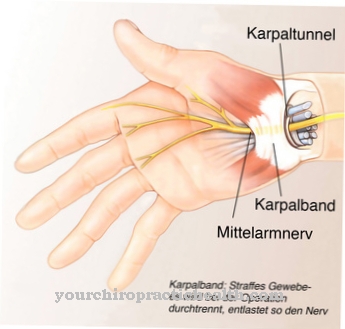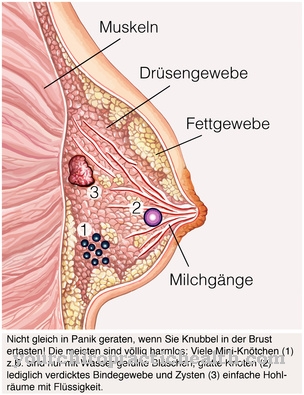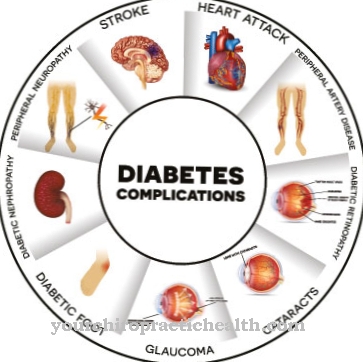The Trisomy 14 is the result of a genome mutation. The symptoms depend on the type of mutation. According to studies, trisomy 14 often leads to miscarriages.
What is trisomy 14?
There is a difference between gene mutations and genome mutations. With gene mutations, certain nucleotides are missing, some nucleotides are swapped or additional nucleotides are added. A genome mutation affects the entire genome. This means that there are additional chromosomes or chromosomes are missing or swapped. Such a changed number of chromosomes lies in the Trisomy 14 underlying.
This is a complex of disabilities that is caused by the triple execution of the genetic material on chromosome 14. Chromosome 14 exists in duplicate in a healthy person. A triple execution therefore corresponds to a genome mutation. Trisomy 14 exists in different variants and, depending on the subspecies, shows variable clinical symptoms.
In addition to the mosaic and partial trisomy 14, medicine knows a so-called translocation trisomy 14 and a free form of the disease. These subspecies are based on different types of mutation. Partial trisomy 14 is most common in living organisms. Since the first description, only a little more than 20 case studies on living patients have been documented.
causes
Genome mutations are caused by genetic material. In mosaic trisomy 14, not all cells of chromosome 14 are present in triplicate. At the same time as the trisomal cell line there is a cell line with a diploid set. This means that there are several karyotypes at the same time. In partial trisomy 14, two sets of chromosome 14 are present in all cells except the germ cells.
However, since one of the chromosomes is elongated and divided into two in a certain section, some of the genetic information is still available in triplicate. In translocation trisomy 14, chromosome 14 is present in triplicate in all cells. One version of the three chromosomes adheres in whole or in part to one of the other two chromosomes and thus shifts. Free trisomy 14 is also based on the triple execution of chromosome 14 in all cells of the body.
However, there is no shift in this form. According to the current state of knowledge, girls are more frequently affected by trisomy 14 than boys. Most fetuses with trisomy 14 die during pregnancy. This relationship often underlies early miscarriages. Of 776 miscarried fetuses, 15 had trisomy 14, according to a study.
Symptoms, ailments & signs
The clinical symptoms of trisomy 14 depend on the percentage of trisomeric cells or are determined by the trisome-present chromosome segment. Because of this, symptomatic generalizations are difficult to make. Often women with affected fetuses show abnormally high amounts of amniotic fluid during pregnancy.
Premature birth before the 37th week of pregnancy are also among the most common symptoms. Even in the womb, the fetuses often suffer from delayed growth. After birth, there are also psychomotor delays in development. The growth is often asymmetrical. Shifted hips or lateral limbs can occur. People's fingers or toes often overlap.
Organic defects such as heart defects can be present. In addition to microcephaly, facial deformities such as a broad forehead or low-set ears, a broad bridge of the nose or facial asymmetries are often present. A long philtrum, a cleft palate, an abnormal palatal curve, and a small lower jaw with a protruding upper jaw can also be among the facial symptoms.
The same goes for a large mouth opening, unusually full lips, and low-set, small, wide-set eyes. Often the patients also have narrow eyelids and slightly drooping upper eyelids. In many cases there is a translucent film on the eyes. Patients' skin is often hyperpigmented. The most common changes in the genitourinary tract include an abnormally small penis and undescended testicles. These symptoms are often associated with renal insufficiency and cognitive disability.
Diagnosis & course of disease
Prenatally, fetuses with trisomy 14 already show abnormalities on ultrasound, which the gynecologist can see as an indication of the trisomy. The free form and the mosaic form of the disease can essentially be diagnosed unequivocally using invasive diagnostic methods, above all with the help of an amniocentesis or a chorionic villus sampling.
The chorionic villus sampling is, however, prone to errors and can result in a false positive diagnosis. A suspected postnatal diagnosis is based on the patient's characteristic physical characteristics and is usually confirmed or excluded by means of molecular genetic analysis. The prognosis depends on the particular mutation and the symptoms in the individual case.
Complications
Trisomy 14 is associated with various complaints, all of which have a very negative effect on the quality of life of the person affected. First and foremost, there is a significantly delayed growth and also a delayed development of the patient. The disease can therefore be diagnosed in the womb.
Those affected also suffer from a cleft palate, so that complications can arise when taking food and fluids. Heart defects also occur frequently as a result of trisomy 14 and can also negatively affect the life expectancy of the child. Due to the malformations of the face, many sufferers suffer from bullying or teasing, especially in childhood, and thus possibly from mental disorders.
Renal insufficiency can also occur, so that in the worst case the patients are dependent on dialysis or a donor kidney. Since trisomy 14 also leads to mental retardation and thus to cognitive and motor impairments, those affected are usually dependent on the help of other people in their everyday lives.
Since direct treatment cannot take place, there are no particular complications. Only the individual complaints are alleviated by various therapies. In many cases, parents and relatives are also dependent on psychological treatment.
When should you go to the doctor?
With trisomy 14, a visit to a doctor is definitely necessary.This disease can lead to death without treatment, so an examination and subsequent treatment must always be carried out. Self-healing cannot occur. An early detection of trisomy 14 always has a very positive effect on the further course of the disease. A doctor should be consulted for trisomy 14 if the person concerned suffers from malformations or deformities that can affect the entire body. In many cases, defects in the heart can also indicate the disease and should be checked by a doctor. In this context, kidney insufficiency often indicates trisomy 14.
Since the disease cannot be completely treated, the relatives and parents of the person affected are often dependent on psychological treatment to prevent depression or further psychological upsets. The treatment of the person concerned depends heavily on the exact complaints and is carried out by the respective specialist. If you want to have children again, genetic counseling should be carried out.
Treatment & Therapy
There is currently no causal therapy available for patients with trisomy 14. Only gene therapy approaches would be considered as causal therapy. However, these approaches have not yet reached the clinical phase. For this reason, the trisomy is currently only treated symptomatically. The treatment depends accordingly on the symptoms in the individual case.
The organic deformities and insufficiencies are the focus of the therapy. For example, the heart defect is corrected as early as possible in an invasive surgical procedure. Kidney failure in children also requires early intervention, which may initially consist of dialysis. In the long run, a kidney transplant is the most sensible way of treatment. The deformities of the face do not necessarily have to be treated. Therefore, they are often ignored initially.
More important is early support for the cognitively improved development of children and physiotherapeutic support for motor skills. Since symptoms such as a heart defect, delayed development or renal insufficiency are not present in all patients with trisomy 14, some people are relatively asymptomatic for their entire life and do not have to seek therapy.
prevention
Since trisomy 14 is a genetically determined mutation, there are hardly any preventive measures available. Since prenatal diagnosis is possible, the parents of the affected fetuses may decide against the child.
Aftercare
Live-born children with trisomy 14 benefit from remedial early support. This should be adapted to the individual abilities of the child. Since this chromosomal disorder in living patients is usually a partial trisomy or a mosaic trisomy, the clinical picture is also very different.
The physical symptoms therefore also require individual assessment and follow-up treatment. While in some cases the main goal is to prevent pain and suffering, others may be able to successfully learn various everyday skills. In the vast majority of cases, children with a free trisomy 14 die in the womb.
Such a miscarriage is stressful for the parents concerned, which may require psychological follow-up care. How long this lasts depends on the wishes of the parents and the individual situation. By consulting human genetics, an attempt is made to clarify the cause of the genetic defect. This also makes it easier to estimate the risk of repetition.
In most cases this is not significantly increased. In the case of a subsequent pregnancy, an amniotic fluid test or a chorionic villus sampling can be performed at the mother's request. As a result, a new trisomy 14 can already be detected during pregnancy. However, these tests also increase the risk of a miscarriage.
You can do that yourself
The symptomatic treatment of trisomy 14, which is performed surgically, medically and physiotherapeutically, can be effectively supported by a whole range of self-help measures.
First of all, it is important to support the affected child as best as possible in everyday life. Physiotherapy and mental training can also be carried out outside of inpatient therapy. It is best for parents to speak to a specialist who can recommend suitable measures to correct the individual malformations as best as possible.
Talk therapy is also useful for the child. Younger children in particular ask a lot of questions about their illness that cannot always be answered by their parents themselves. Therefore, an expert must be called in to provide the child with the best possible information. Child-friendly books about the hereditary disease also help to build a healthy relationship with the disease.
In addition, parents need to watch the child closely so that they can react quickly to complications. The apartment must be equipped for disabled people so that there is no risk of falls or accidents. In addition, suitable special schools and kindergartens for the sick child should be sought at an early stage, as the registration deadlines are often several years.

.jpg)











.jpg)

.jpg)
.jpg)











.jpg)